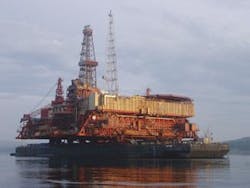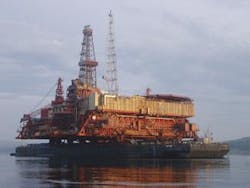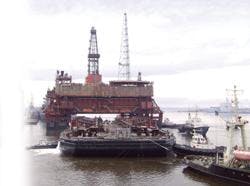World's heaviest topsides dismantled for new service off northern Russia
Jeremy Beckman, Editor, Europe
Topsides facilities from a decommissioned North Sea platform deck are being upgraded for new service in Russia's White Sea. The former Hutton field TLP topside, weighing 19,000 tonnes, was de-mated from its substructure last July in a fjord outside Murmansk, northwest Russia. It was then transported east to a yard in Severodvinsk and transferred onto two pontoons, where it is being upgraded at present for the Prirazlomnoye offshore oilfield development.
The de-mating exercise involved the world's heaviest floatover operation from a redundant platform. The subsequent mating operation from the barge onto the two pontoons was also the world's largest. Work was managed by Hedron Engineering, which was contracted by Federal State Unitary Enterprise Sevmash Severodvinsk, with maximum possible use of Sevmash's own in-house resources. Hedron, reporting to Sevmash on technical and commercial matters, also engineered and supervised the program, without the use of specialist crane or purpose-built abandonment vessels.
Hedron, based in St. Albans, UK, is a British company that unites the resources of BDL Engineering and Sweden's Carat Process Teknik. BDL was established in 1992, working offshore primarily on North Sea projects and onshore developments in the Caspian region. Carat was formed in 1994, and has worked mainly on process packages for use in Scandinavia and the Russian Federation.
null
Jenan Kazim, Hedron's project and engineering director, has 20 years experience of offshore projects. This includes working as an installation engineer on numerous North Sea platforms under contract to Mobil, ETPM, and Heerema. While with Bechtel in 1984, he also had a spell on Hutton when the TLP – the world's first – was brought onstream by then-operator Conoco.
Prirazlomnoye is a large oilfield located in shallow water in the Barents Sea. The reservoir, which is fairly regular, is capable of producing up to 100,000 b/d, with small quantities of associated gas. The required process equipment is also conventional, except for the environmental conditions. In winter, air temperatures can dip to -56° C, and the sea is totally covered by ice. Icebreaking shuttle tankers are required to transport the oil to storage facilities onshore.
Sevmorneftegas, which is owned jointly by Gazprom and Rosneft, has overall project management responsibility for the field's development. FSUE Sevmash, a Russian naval construction specialist (as main contractor) is building the platform's ice-resistant substructure at its yard in Severodvinsk. It is also charged with outfitting the process facility, and for managing marine operations. According to Kazim, "They have a very modern facility, which is equipped for fabricating and outfitting all types of offshore and onshore structures. They also have a very skilled labor force. But this project has finally given them the opportunity to demonstrate their capability for outfitting platform topsides and building substructures to offshore standards."
Design change
The initial concept for Prirazlomnoye, devised by Halliburton Brown & Root, involved a newbuild topsides on an ice-resistant substructure. However, when the Hutton TLP became available, an upgrade was considered a cheaper option, which might also accelerate the field's development. The TLP, which had been decommissioned in 2000 by operator Kerr-McGee, had been moored in a fjord outside Stavanger. Sevmorneftegas had purchased the platform and transported it to Murmansk, where it was de-mated. According to Kazim, Murmansk was chosen as the location for this work, because of its sound industrial infrastructure and because the sea locally does not freeze over, due to the influence of the Gulf Stream.
Hedron was invited to bid for this work against established decommissioning companies such as Aker Maritime.
"We won," he says, "primarily because of our price, and our commitment to the operator's very tight schedule, but also in part due to our size and flexibility. Our ethos is to work with Russian companies in a way that used as much of their resources as possible – both in terms of technical capabilities, marine spread, and construction – with the explicit aim of minimizing the project's cost, but without in any way compromising safety."
The project then had to be engineered and managed to satisfy these objectives. Hedron's knack of cutting costs without cutting corners showed early on in its choice of transportation barge.
"We chartered the BOS 600 from Saipem. It was out of service in drydock in Glasgow, and it was out of license. At that time, all the other suitable barges operated by the big offshore contractors were in service, or only available during a limited weather window, and we did not want to be tied in this way. Our contract with Saipem was flexible, allowing us to extend our contract far beyond the limited window in stages."
The flexibility was very important, as this type of operation had never been performed before in Russia, and Hedron was not sufficiently well informed about local legal and customs issues. Also, they did not know exactly when the White Sea would be ice-free, or whether they would find and then procure suitable pontoons in sufficient time to transfer the topsides from the barge.
"Securing the BOS 600 barge contract and having all phases of the operation insured were for us the most critical aspects of this project. Normally, these things are all in place prior to the main contract awards, but in this case that was not possible, due to the project's very fast track schedule. The BOS 600 had 60,000-tonne capacity, and it was competitively priced. Prior to us taking on our charter contract, the vessel was drydocked at the Harland & Wolff shipyard in Belfast. We had to ensure that all essential equipment such as ballast pumps and winches were brought up to scratch to achieve new Lloyds certification."
null
De-mating schedule
Hedron's first view of the TLP came during a visit to Vatsfjord near Stavanger in August 2002, as part of the bidding process. "We looked it over with a view to conceptualizing and costing the project, in terms of the amount of cutting required, evaluating the required ballasting procedures, how to isolate all the piping and electrical systems, and how long it would take to cut the deck loose. The condition of the deck and its equipment, accommodation, piping, and steelwork was very good. Our client aimed to retain as much of the existing equipment as possible, and to refurbish this in line with the detailed requirements of the new field. This work is still ongoing."
When the contract was awarded that December, it had already been decided that de-mating of the topsides from the substructure would be done in Murmansk in early summer 2003. According to Kazim, "Our objective was to get the barge, with its topsides cargo, to Severadovinsk on the White Sea coast, which does ice over for six months of the year. This would mean transferring the topsides onto pontoons at the yard's quayside some time before October. It was a tight schedule, as something on this scale had never been done before in Russia, let alone anywhere else. Everything had to come together at the right time."
Global Marine & Maritime was subcontracted to help with and supervise the marine operation and transportation. To save time, the detailed engineering, construction of the outfitting steelwork, and selection of required equipment all had to be conducted in parallel.
"As we were relatively unknown in the industry, and undertaking the world's heaviest de-mating operation, certain people viewed us with suspicion," Kazim says.
"Prior to the contract award, engineers from both Sevmash and Sevmorneftegas gave us a thorough technical evaluation. In Russia, even top managers such as Dr Chernov, general director of Sevmorneftegas, and his deputies, and impressive technical backgrounds. If necessary, they involved themselves in the technical detail before making any commitment."
In readiness for the de-mating, the newly refurbished BOS 600 was sent to Tromso in northern Norway for outfitting, and to take delivery of equipment such as winches and Yokohama fenders. Hydraulic jacks and electrical equipment needed to modify Hutton's onboard ballast system were sent directly by road to Murmansk. Modification of the ballast system was done under Global Maritime's supervision: this facilitated use of Hutton's own ballast system after the topsides were de-mated from the Hutton substructure.
"Previously, we had quotations of over $2 million for the external ballast systems," Kazim says. "This was unacceptable to our client, so we had to find another way."
Normally, the whole weight of the deck would be lifted with the hydraulic jacks alone, the load being transferred onto the barge, while the weight and weight distribution is simultaneously controlled. However, this approach would have been very expensive, requiring more than 100 250-tonne capacity hydraulic jacks operating at 75% capacity to lift 19,000 tonnes.
"We therefore decided to first transfer 85% of the weight by ballasting the platform down, so that effectively we would only have 3,000 tonnes to lift. Therefore, we only used 16 jacks. We knew how much weight each jack could take, and from that we calculated the amount of ballasting required. The weight transfer and distribution up to 85% were calculated from the amount of ballast water being transferred from Hutton and onto the barge to maintain level trim. The final 15% of the load transfer is the critical operation, because the barge and platform start to uncouple, and the columns have to move away from the deck evenly and as quickly as possible."
It took less than 14 weeks to engineer and fabricate nearly 700 tonnes of outfitting steel, outfit the barge, and transport it to Murmansk for de-mating. "We then needed to wait for a wave height of less than 0.75 m, and a wind speed of less than 15 knots. The weather is generally good in Murmansk in May, when the barge was positioned between the TLP's legs. The winches were used to line up the docking pins on the barge with the docking cones on the topsides. It was a credit to the dimensional surveyors on the barge and the topsides that both the primary and secondary docking pins lined up within millimeters, although they were more than 85 m apart."
Once the decision was taken to de-mate, the operation went smoothly, he adds. "First, 85% of the weight was transferred onto the barge, and the topsides were then lifted onto the hydraulic jacks. We knew in advance how much ballast would have to be put in each of the columns. We continued ballasting the columns down until we had a 0.75-m clearance between the columns and the topsides. Basically, we then pulled the barge out. A lot of companies would have used an external ballast system. What we did was to employ the platform's emergency generator to maintain power for the platform's ballasting system, once we had detached the topsides." The ballasting operation was engineered and controlled by Global Maritime.
"Ballasting was performed at a rate of around 1,000 tonnes/hr, with the final stages taking six hours. We were transferring 20%, then stopping, transferring 50%, and then stopping again to check the supports. Obviously you need to ensure that the loads are being distributed onto the barge as anticipated. Once detachment had been completed, the columns were ballasted back up to a safe position and left in Murmansk (these were not our responsibility)."
Pontoon outfitting
The de-mating operation was completed end-July 2003, and immediately the BOS 600 set sail with its topsides cargo for Severo-dvinsk, a journey that took five days. On arrival at the Sevmash yard, the barge was moored at the quayside until the two pontoons onto which the topsides would eventually be transferred were ready. The pontoons – measuring 17.7 m wide, 15 m deep and 80 m long – had also been used in the 1980s for installation of a Condeep platform offshore Norway and for installation of the Oresund bridge between Denmark and Sweden in the 1990s.
"We had had these surveyed in Stavanger both by Global Maritime and by Germanischer Lloyd," Kazim says, "and the onboard equipment was refurbished to bring it up to class, then certified. The pontoons were then transported from Bergen to a quayside in Tromso, where they were outfitted with the required steelwork."
Each pontoon was fitted with 350 tonnes of steelwork, sufficient to support a load of 26,000 tonnes (although the Hutton topsides weighed only 19,000 tonnes). This was necessary, to make allowance for snow, ice, and the general equipment upgrades. The pontoons were towed to Severadovinsk in mid-September.
"The subsequent mating operation took place when we were assured of a three-day weather window," Kazim said. "This operation was performed using Sevmash's marine vessels, providing 10-80 tonnes of bollard pull, under supervision of Sevmash personnel. Once the mating operation was concluded, the topsides on the pontoon were moored to the quayside for subsequent upgrading."
All engineering and marine operations were verified and approved by the Russian Maritime Register (RMR). "I have worked with both Lloyds and DNV, and in terms of professionalism and technical ability, RMR is just as good," Kazim says.
At Prirazlomonye, the topsides will be supported by an 80,000-tonne concrete caisson substructure, which is currently under construction at Sevmash and due to be completed in 2006. Concurrently, the same yard is refurbishing or replacing the Hutton process, drilling, and accommodation modules. Living quarters will be expanded to accommodate 80 platform personnel.
Hedron hopes also to be invited to bid for the topsides/substructure installation program. The bidding process starts later this year.
"This will be a horizontal skidding operation, not vertical like the de-mating," Kazim says. "The main difficulty will be transferring the weight of the topsides from one vessel onto the substructure. Also, the sea locally ices up for six months of the year, which constricts the schedule, and the area is prone to strong currents and Arctic winds. We would aim again to use local facilities as much as possible, and to design our scheme around their processes. For the de-mating project, we had Russian personnel working with us at every stage. Our cooperation was good."
Kazim says that they always discussed exactly what was being done. And despite the fact that the Russian labor force had never done offshore rigging operations before, there was not a single injury, or even scratched paint, for what was the world's largest topsides transfer operation.
"I think larger western contractors are not able to assimilate outside technicians in the same way. It's easier for small companies like ours to fit in and work with Russian contractors, because we don't have the level of bureaucracy prevalent among larger western companies. If some problem arises – contractual or technical – I can make a decision on the spot. It is not like other companies, where the lead engineer must speak to the project manager and then to the legal department. That kind of bureaucracy slows the project down."
Kazim says that the North Sea is very conservative where this type of work is concerned. "Contractors there have very established procurement networks, they always go to the same people. But we have proven that with a team of just 10 in-house engineers, we can achieve what much larger and more established heavy-lift companies have done, but at a much lower cost."


